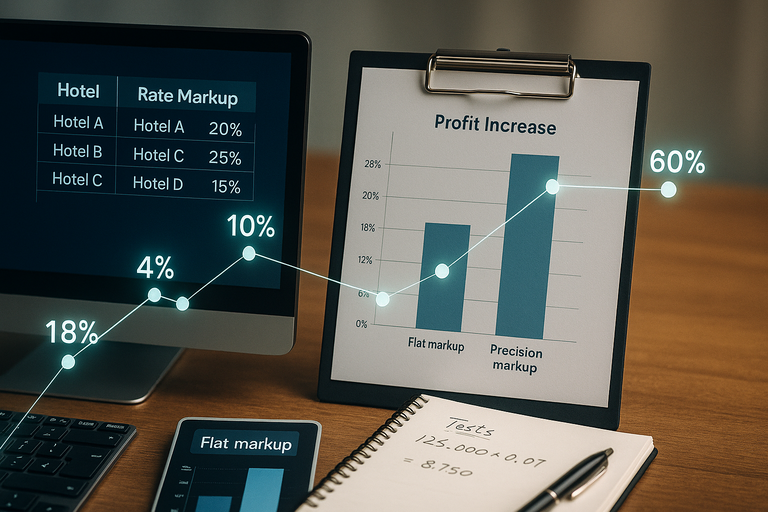Whether you manage pricing for a boutique hotel or run an OTA handling millions of daily searches, markups often feel like a constant struggle. Most teams rely on familiar routines, thinking, “+6 % worked last year, so let’s stick with it.”
Real-world scenario: At sunrise on 12 December, a mid-sized bedbank faced an alarming scenario—110 million hotel searches overnight, but profit per booking plummeted below 1 % and their API expenses surged by €12,000 within hours. After six weeks of targeted markup optimization, the same traffic yielded a 28 % increase in contribution margin without sacrificing significant number of bookings.
Seven effective strategies for turning a flat +6 % into precise, data-driven pricing
1 | Centralize your data Combine search logs, booking histories, and channel costs into one analytics hub. Unified data helps finance and product teams swiftly resolve pricing debates.
2 | Create transparent, user-friendly rules “Apply +2 % for non-refundable bookings, +3 % in high-risk markets.” A user-friendly rule editor empowers revenue teams to implement changes instantly, no coding needed.
3 | Harness predictive analytics A simple ML model predicts booking likelihood. Increase markups for high-intent shoppers, reduce for price-sensitive ones—typically boosting margins by 3–5 percentage points.
4 | Evaluate distribution channels rigorously Distinguish partners who generate valuable, converting traffic from those sending low-quality searches. Adjust markups accordingly to incentivize better channel performance.
5 | Experiment systematically Implement built-in A/B or multi-armed-bandit testing, automatically routing traffic toward the highest-performing pricing strategies, delivering insights quickly.
6 | Optimize edge pricing Cache calculated prices within your edge servers (closest to the end-user). Deliver exceptionally fast response times (< 50 ms) while sophisticated rules operate seamlessly in the background.
7 | Provide transparency Track each pricing decision—rules triggered, risk scores used—and visualize them in real-time dashboards. Clear data builds trust with finance and helps technical teams spot issues proactively.
Key takeaway
Effective markup strategies aren’t about overcharging travelers—they’re about precisely aligning pricing with market dynamics, risk, and customer intent. Start with straightforward rules, integrate unified data, and add predictive insights. For the fastest implementation, leverage LodgingBase’s API and intuitive rule builder—a single solution addressing all seven tactics. Explore markup impact calculator below to quantify how small changes can significantly improve your margins.
